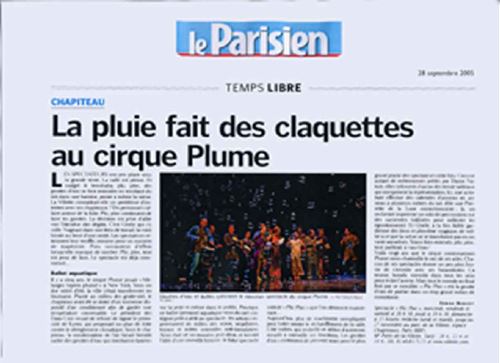Le Parisien28 September 2005
Singing in the rain at Cirque Plume
Erwan Benezet
 Big top
Big top
THE AUDIENCE have taken their places under the big tent. The show is sold out. And despite the commotion, drip, drop, water droplets make themselves heard falling from the sky into a bowl placed, just then, on the stage. Does La Villette have a maintenance problem with its big-tops? Some employees bustle about the leak. Drip, drop, the leak persists. A decision is made to go up and see what the problem is. The task falls on Gisèle’s shoulders. Swimming in her work overalls, she is hoisted up on the end of a rope. The spectators hold their breath just like they do during a trapeze act. Then they almost jump our of their skins when she falls, narrowly missing the ground. Plic Ploc, everything is not as it seems. The show has actually already begun...
An aquatic ballet
Five years ago, Cirque Plume was playing "Mélanges (opéra plume)" in New York. Under the hot summer sun, the city turned into a furnace. Planted in the middle of the skyscrapers, the big-top was endowed with an immense air-conditioning system in order to keep the inside temperature comfortable. The president of the U.S. had just refused to sign the Kyoto Accord, which proposed a plan combating climate change. Under the big-top, the condensation turned into droplets of water droplets that sprinkled the stage and even the audience. This aquatic ballet that came from the sky integrated itself bit by bit into the show: the artists improvised amongst the buckets, hoses and other anti-flood devices. Thus an act was born, then two, and soon an idea for an entire show: the future show called "Plic Ploc" that we are discovering right now...
Today there is no more complicated machinery to struggle against the heat. The Indian summer that beautified the beginning of this fall serves its purpose well. The water droplets continue to fall, but this time they are there for the pleasure of the audience. Like so many metronomes provided by Mother Nature, they lend rhythm to each of the thirty scenes that make up the show. Here, an acrobat executes turns from one ring to another several metres from the ground, like a feminine contortionist Pierrot doll; there an orchestra improvises a percussion solo on pots and pans used to collect the water drops. Gisèle, both a faithful guardian of the stage and a magical plumber, makes sure the place doesn’t turn into a vast aquarium. Otherwise, plic ploc, drip drop, and everything would be washed downstream!
For twenty years the contemporary Plume has tickled our noses with the feathers of its wings. Each of its shows encourages us to fly away with these high-wire walkers a little bit more. They twirl, they jump, they flip in every direction to avoid the downpour. "Plic Ploc" is a droplet of poetry in an overly large ocean of monotony.









